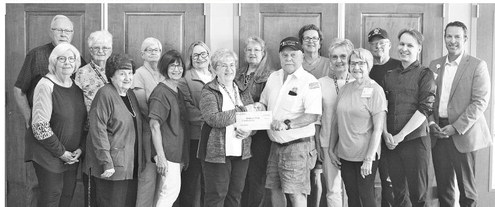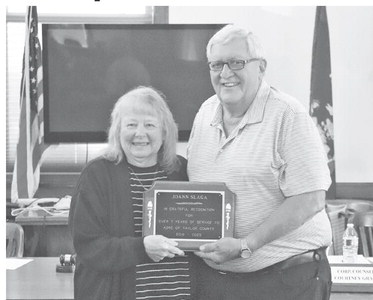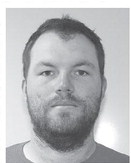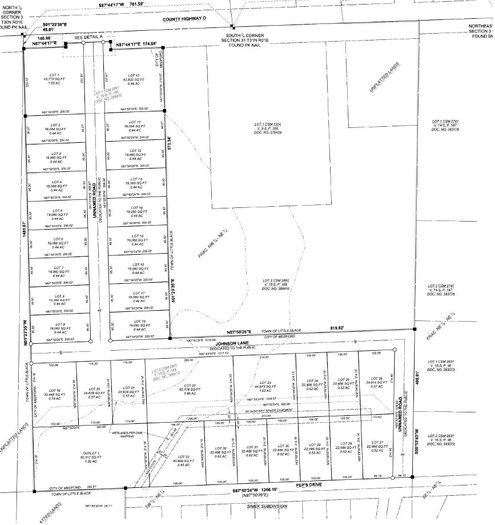Campground development proposed for fairground


The Taylor County Fair is busting at the seams when it comes to exhibitors, vendors and workers requesting to camp at the fair each year.
According to fair volunteer Mark Wesle this year the fair saw 34 campers at the fair with 18 of them from exhibitors. The fair offers limited camping options which helps for exhibitors needing to care for their animals and others to reduce the need to travel. Campers currently pay a token fee which helps cover the cost of electricity used.
Wesle explained to members of the Taylor County Buildings and Grounds committee that it is becoming increasingly challenging to find locations on the grounds to house all the requests. He proposed a solution that could also bring in ongoing revenue for the county by developing a portion of the county-owned land directly to the north of the DNR Ranger Station as a campground. He estimated the county could fit between 18 and 20 camping spots suggesting that like the rest of the fairgrounds, the campground area would be used by the fair for the fair weekend and the rest of the year be available to be rented out by the county to generate revenue.
It was noted that water, sewer and electric service are available to that area, with cost for the project dependent on what sort of facilities would be needed to meet codes. Buildings and grounds director Joe Svejda said there are pre-fabricated structures with bathrooms, such as those available at other campgrounds in the county, which could be placed there without much additional work.
Svejda was supportive of the campground idea, but said it should be part of a larger usage plan for the former Bauer property, a 9-acre parcel that was purchased by the county several years ago to address storage needs. Various county departments including the highway department, sheriff’s department, land conservation and forestry department are using space in the sheds and building on the land for cold storage of items. These buildings predated the county’s purchase of the parcel and Svejda noted there are several that will be needing work done to them in the coming years.
Svejda suggested the county take the time to develop an overall plan of how the land should be used to maximize benefit to the county. He said this would help in making decisions to repair, tear down, or relocate the structures currently on the property.
Svejda noted that existing use of the buildings, particularly the highway department, as freed up space in the fairgrounds buildings for the county to rent out winter storage. This rental revenue goes into the county’s general fund.
“What does the county want to do moving forward?” Svejda asked, saying the county should make a decision on the whole property before investing in developing it piecemeal.
Committee member Jim Gebauer agreed and suggested plans be drawn up to show how the entire parcel could be used, along with potential cost estimates. He said the 9-acre area is large enough to be used for multiple county needs.
The primary spot for campers currently on the fairgrounds is the green space between the swine and sheep barn and the fence along Hwy 64.
Wesle said he is working to get something started for a long-term fix to the camping situation. He also brought forward requests for improvements to increase accessibility to the grandstand and other parts of the fairgrounds.
He suggested moving the ramp from the west side of the grandstand to the east side and the county putting in additional blacktop to make it easier for those with mobility issues to access the stands.
“If you have ever tried pushing a wheelchair along grass, it is not easy,” said Catherine Lemke, the county board representative to the fair board.
Wesle also asked for some blacktop work to help make the entrance to the fair office more accessible. The grounds and buildings on the fairgrounds are owned and maintained by the county.
Wesle said he is just trying to look at ways to make the fairgrounds a little more safe by eliminating areas where cords or hoses would lay across walkways. Svejda praised volunteers such as Wesle and others who put in long hours and save the county considerable money with their volunteer labor.
He gave the example of the light replacement project in the grandstand area where the work donated by volunteers cut the estimated project costs in half.
Svejda will work with the fair board and volunteers to address needs at the property.
In other business, committee members:
• Approved a budget to send to the finance committee. The budget is similar to ones submitted in past years for overall spending, but some areas were budgeted that would have been done with carryover funds. There was a lengthy discussion on the number of building-specific carryover accounts with suggestions that those funds could be pooled into fewer accounts to reduce the overall number of carryover line items.
• Approved, with member Rod Adams opposed, to continue GPS tracking equipment in the department vehicles that leave the city of Medford. Svejda said the tracking devices are not routinely monitored and that he is working on how it was presented to the public that they are there for safety measure to find the location of a county vehicles if crew members do not report back from job sites. The county’s handbooks requires departments to review which vehicles, if any, will have the tracking devices on a yearly basis.
• Received an update on the work on the Aging and Disabilities Resource Center (ADRC) building, the contractor is waiting on trusses to be delivered in order for the exterior work to continue. Work has taken place in the former office space of the historical society. Svejda asked, and received permission to spend additional funds to address concerns over the brick facing on the front of the building. Svejda said in some areas it was ready to fall off and wanted to do the work while crews are there working on the addition to the building. He estimated it would add $25,000 to the overall project.
• Heard from Svejda that he will be needing to put out on bid the replacement of 30-year-old air conditioning equipment at the Taylor County Education Center. The building is rented by the Rural Virtual Academy, Headstart, and Adult Diploma Academy. Svejda noted that, after the county-owned cellular tower, that building generates the most rental income for the county of any countyowned building.
• Gave the blessing to allow the use of the Taylor County Community Center space to be used for the monthly blood drives that are currently held at the Medford Fire Hall. The idea was raised after the county’s employee committee held drives there recently and those working the blood drive noted it was a better location for both volunteers and donors. Adams said he did not feel it would be right to charge for use of the facility for regular blood drives.





